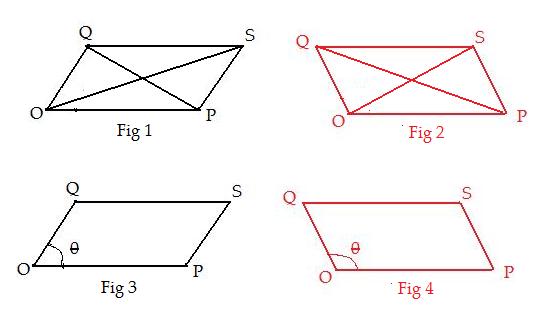 But now arguments for the black and red parallelograms are different.
But now arguments for the black and red parallelograms are different.

Also let θ be the angle at O. So that a genuine parallelogram exists,
0° < θ < 180°.
There are actually two situations (see Fig 3 and Fig 4):
0° < θ ≤ 90° and 90° < θ < 180°.
From vertex Q draw diagonal QP and drop a perpendicular down to line OP. Then pairs of right triangles are formed:
triangle OMQ and PMQ
in both figures Fig 5 and Fig 6.
By the Pythagorean theorem
|OQ|2 = |OM|2 + |MQ|2,
|QP|2 = |PM|2 + |MQ|2
in both figures. Subtract the two equations to eliminate |MQ|2 to get
(&) |QP|2 − |OQ|2 = |PM|2 − |OM|2
which is true for both parallelograms.
 But now arguments for the black and red parallelograms are different.
But now arguments for the black and red parallelograms are different.
In the black parallelogram, eliminate |PM|2 by substitution |PM| = |OP| − |OM| whose square is
|PM|2 = |OP|2 − 2 |OP| |OM| + |OM|2
Inserting the right side of this equation for |PM|2 in equation (&) produces
(@) |QP|2 − = |OP|2 + |OQ|2 − 2 |OP| |OM|.
In the red parallelogram, eliminate |PM|2 by substitution |PM| = |OP| + |OM| to get from (&)
(@) |QP|2 − = |OP|2 + |OQ|2 + 2 |OP| |OM|.
From vertex S draw diagonal OS and drop a perpendicular down to line OP. Then pairs of right triangles are formed:
triangle ONS and PNS
in both figures Fig7 and Fig 8.
By the Pythagorean theorem
|PS|2 = |PN|2 + |NS|2,
|OS|2 = |ON|2 + |NS|2
in both figures. Subtract the two equations to eliminate |NS|2 to get
|OS|2 − |PS|2 = |ON|2 − |PN|2
But |PS| = |OQ| so
(&&) |OS|2 − |OQ|2 = |ON|2 − |PN|2
which is true for both parallelograms.
But now arguments for the black and red parallelograms are different.

In the black parallelogram, eliminate |ON|2 by substitution |ON| = |OP| + |PN| whose square is
|ON|2 = |OP|2 − 2 |OP| |PN| + |PN|2
Inserting the right side of this equation for |ON|2 in equation (&&) produces
(%) |OS|2 = OP2 + |OQ|2 + 2 |OP| |PN|.
In the red parallelogram, eliminate |ON|2 by substitution |ON| = |OP| − |PN| to get from (&&)
(%) |OS|2 = |OP|2 + |OQ|2 − 2 |OP| |ON|.
Actually all the black parallelograms are the same. So right triangle OQM and PSN are congruent. Hence |OM| = |PN|.
Similarly, OQM and PSN are congruent. Hence OM = PN. Equations (%) and (%) become
(@@) |OS|2 = OP2 + |OQ|2 + 2 |OP| |OM|.
(@@) |OS|2 = OP2 + |OQ|2 − 2 |OP| |OM|.
.
Addition of equations (@) and (@@) and addition of equations (@) and (@@) produce the desired equations
|QP|2 + |OS|2 = 2|OP|2 + 2|OQ|2
|QP|2 + |OS|2 = 2|OP|2 + 2|OQ|2